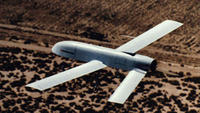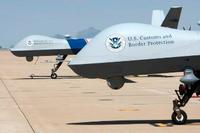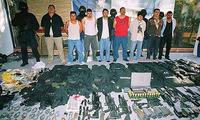-
U.S., U.K. military leaders address climate change's role as a global threat multiplier
Conflict brought on by droughts, famine, and unwelcome migration are as old as history itself. Yet, a growing number of military analysts think that climate change will exacerbate these problems worldwide and are encouraging countries to prepare to maintain order even as shrinking resources make their citizens more desperate; Rear Admiral Neil Morisetti: “We see climate change as a threat multiplier, as a catalyst for conflict”
-
-
Obama administration sues Arizona over strict new immigration law
The Department of Justice filed a lawsuit in federal court in Arizona, asking for an injunction to prevent the state’s strict new immigration law from taking effect on 29 July; the administration argued the Arizona law, which requires state and local police to investigate the immigration status of anyone they reasonably suspect of being an illegal immigrant, is unconstitutional and would sap law enforcement resources; the lawsuit is part of a broader approach by President Barack Obama to deal with the 10.8 million illegal immigrants believed to be in the country, arguing that immigration is the responsibility of the federal government not each state; “Seeking to address the issue through a patchwork of state laws will only create more problems than it solves,” U.S. Attorney General Eric Holder, said in a statement
-
-
Lawmakers, DHS look for new border security technologies, fresh approach

With SBInet likely to be cancelled (one lawmaker notes that at the current pace of deployment, SBInet would take 323 years to deploy across the 2,000-mile Southwest border — to say nothing of the effectiveness of the project’s technology), the search is on for new border security technologies; DHS is ramping up a program that will explore new public and private sector technologies that could be deployed along the border ; there are plans to develop a system that will link information systems of state, local, and tribal law enforcement entities along the border with those at DHS and the Justice Department; enhance analytic capabilities of fusion centers; and establish a suspicious activities reporting program
-
-
DHS officials meet skeptical reception at Aspen forum on state of U.S.-Mexico border
Reporter writes that there were audible murmurs of disbelief from the audience when Deputy Secretary of Homeland Security Jane Holl Lute noted that her boss, DHS secretary Janet Napolitano, has said “many, many times, the southern border has never been more secure than it is today”
-
-
Bullets fired from Mexico strike El Paso, Texas, city hall

The trend of criminal activity in Mexico spilling into the United States is steadily increasing — but this is new: seven bullets struck the ninth-floor office of Assistant City Manager Pat Adauto on the west side of the El Paso City Hall building; the gunfire may have been stray shots from Juarez, Mexico, on the other side of the border, police said; one of the bullets came through the wall and knocked over a picture frame; one city official: “Now that something like this has happened we’ll put in place more formal procedures so that if something like this occurs again we can have a major notification quickly throughout the building so people can move away from the windows”
-
-
Obama to deliver major speech on immigration today
In his first major speech on immigration since taking office, Obama hopes to rally new momentum behind the push for an immigration overhaul by explaining why he thinks a comprehensive approach is the only way to fix what he and others say is a system badly in need of repair
-
-
Arizona to release immigration training plan for police officers
The tough Arizona immigration law will take effect on 29 July; Arizona officials will today release a training program designed to teach police officers to enforce the crackdown on illegal immigration without racially profiling; an hour-long video and supporting paperwork will be sent to all 170 Arizona police agencies and publicly released
-
-
U.S. has no plan to keep nuclear bomb materials from crossing border
In 2006 the George W. Bush administration announced a $1.2 billion project to deploy thousands of scanners for screening vehicles and cargo at U.S. ports to block the importation of radioactive materials that could be used to make a bomb to protect the United States; the scanners — known as the advanced spectroscopic portal (ASP) machines — proved a failure, and in February, following one setback after another, officials abandoned full-scale deployment of the machines; GAO says that the attention and resources invested in the ill-fated ASPs delayed the creation of a “global nuclear detection architecture” to protect the United States
-
-
Undocumented immigrants flee Arizona ahead of harsh law going into effect
Undocumented workers begin to flee Arizona ahead of Governor Jan Brewer’s immigration law going into effect; businesses suffer — and experts say the exodus could really hurt the state’s economy
-
-
More UAVs, personnel, money for U.S.-Mexico border protection

The Obama administration bolsters U.S.-Mexico border protection; the Federal Aviation Administration (FAA) approved UAV flights over the Texas border from the Big Bend to the Rio Grande Valley; after Republicans in the Senate threatened to seek funds for 6,000 National Guardsmen to stop human and drug smuggling, Obama decided to deploy 1,200 Guard members in Southwest states until more Border Patrol and Immigration and Customs Enforcement (ICE) officers could be hired and trained; the president sent his $600 million funding request to Congress earlier this week to hire 1,000 new Border Patrol agents, 160 ICE agents, 20 CBP officers, and 20 new CBP canine teams
-
-
Mexican cartels operate permanent lookout bases in Arizona to monitor U.S. law enforcement
Mexican drug cartels now maintain permanent lookout bases in strategic locations in the hills of southern Arizona from which their scouts can monitor every move made by law enforcement officials; the scouts are supplied by drivers who bring them food, water, batteries for radios — all the items they need to stay in the wilderness for a long time; “To say that this area is out of control is an understatement,” says a border patrol agent
-
-
Police chief: Cartels threaten U.S. law enforcement in Arizona

In the first public incident of its kind, Mexican drug cartels are making direct death threats to U.S. law enforcement officials in Nogales, Arizona, the police chief there says; less publicly, the drug cartels have been targeting U.S. law enforcement personnel for intimidation and assassination for sometime now; members of the cartels have even found a new way to make the task easier: using “cloned” Border Patrol vehicles; driving a Border Patrol look-alike vehicle allows the assailants to get closer to their targets without arousing suspicion
-
-
DHS looking to UAVs to bolster border security
With the future of SBINet — the ambitious but trouble-plagued virtual fence project along the U.S.-Mexico border — unclear, DHS says it is now considering expanding its UAV fleet to beef up border security
-
-
$800 million for 53-mile of border fence (it was supposed to be 655 miles)
The original plan of the Secure Border Initiative (SBINet) called for spending $833 million to build a virtual fence — a system of sophisticated sensors, cameras, and other barriers — along 655 miles of U.S.-Mexico border in Arizona, New Mexico, and a slice of Texas, at a cost of about $1.2 million per mile; Boeing, the prime contractor, used $800 million to build the system along only 53 miles of border at a cost of $15.1 million per mile; the virtual fence’s technology is now judged a failure
-
-
Border Patrol decides not to purchase a balloon to aid communication among agents
An Arizona-based company makes a balloon that carries light-weight communication gear at 60,000 to 100,000 feet above the earth, and can extend the range of two-way radios on the ground as much as 40-fold; the Border Patrol showed interest in the balloon as a means to help its agents better communicate with each other and with law enforcement in remote border areas; but Border Patrol decided not the to pursue the balloon option
-
- All
- Regional
- Water
- Biometrics
- Borders/Immig
- Business
- Cybersecurity
- Detection
- Disasters
- Government
- Infrastructure
- International
- Public health
- Public Safety
- Communication interoperabillity
- Emergency services
- Emergency medical services
- Fire
- First response
- IEDs
- Law Enforcement
- Law Enforcement Technology
- Military technology
- Nonlethal weapons
- Nuclear weapons
- Personal protection equipment
- Police
- Notification /alert systems
- Situational awareness
- Weapons systems
- Sci-Tech
- Sector Reports
- Surveillance
- Transportation
Advertising & Marketing: advertise@newswirepubs.com
Editorial: editor@newswirepubs.com
General: info@newswirepubs.com
2010-2011 © News Wire Publications, LLC News Wire Publications, LLC
220 Old Country Road | Suite 200 | Mineola | New York | 11501
Permissions and Policies
Editorial: editor@newswirepubs.com
General: info@newswirepubs.com
2010-2011 © News Wire Publications, LLC News Wire Publications, LLC
220 Old Country Road | Suite 200 | Mineola | New York | 11501
Permissions and Policies
